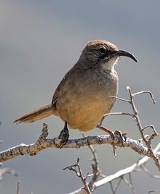
California Thrasher
Encyclopedia
The California Thrasher (Toxostoma redivivum) is a large thrasher
found primarily in chaparral
habitat in California
and Baja California
. Similar to the Crissal
and Le Conte's Thrasher
s in habit, the California Thrasher is the only species of Toxostoma throughout most of its limited range. Like most thrashers, it rarely flies in the open, preferring to keep hidden in dense brush. Therefore, while it is common throughout much of its range, it is rarely seen.
At about 12 inches (30 cm) and nearly 85 grams (3 oz), the California Thrasher is the largest species of mimid. It is generally brown, with buffy underparts and undertail (unlike the Crissal). It has a dark cheek pattern and eye-line, and unlike most thrashers, has dark eyes.
Thrasher
Thrashers are a New World group of passerine birds related to mockingbirds and New World catbirds. Like these, they are in the Mimidae family. There are 15 species in one large and 4 monotypic genera.These do not form a clade but are a phenetic assemblage...
found primarily in chaparral
Chaparral
Chaparral is a shrubland or heathland plant community found primarily in the U.S. state of California and in the northern portion of the Baja California peninsula, Mexico...
habitat in California
California
California is a state located on the West Coast of the United States. It is by far the most populous U.S. state, and the third-largest by land area...
and Baja California
Baja California
Baja California officially Estado Libre y Soberano de Baja California is one of the 31 states which, with the Federal District, comprise the 32 Federal Entities of Mexico. It is both the northernmost and westernmost state of Mexico. Before becoming a state in 1953, the area was known as the North...
. Similar to the Crissal
Crissal Thrasher
The Crissal Thrasher is a large thrasher found in the Southwestern United States to central Mexico....
and Le Conte's Thrasher
Le Conte's Thrasher
The Le Conte's Thrasher is a pale bird found in the Southwestern United States and northwestern Mexico. It prefers to live in deserts with very little vegetation, where it blends in with the sandy soils...
s in habit, the California Thrasher is the only species of Toxostoma throughout most of its limited range. Like most thrashers, it rarely flies in the open, preferring to keep hidden in dense brush. Therefore, while it is common throughout much of its range, it is rarely seen.
At about 12 inches (30 cm) and nearly 85 grams (3 oz), the California Thrasher is the largest species of mimid. It is generally brown, with buffy underparts and undertail (unlike the Crissal). It has a dark cheek pattern and eye-line, and unlike most thrashers, has dark eyes.
External links
- California Thrasher videos on the Internet Bird Collection
- California Thrasher at Avibase
- California Thrasher at USGS
- California Thrasher photo gallery VIREO
- Photo-(Field Photo--High Res); Article - "Birds of San Diego coastal scrub"
Book
- Cody, M. L. 1998. California Thrasher (Toxostoma redivivum). In The Birds of North America, No. 323 (A. Poole and F. Gill, eds.). The Birds of North America, Inc., Philadelphia, PA.
Articles
- Academy Of Natural Sciences Of P. (1998). California Thrasher: Toxostoma redivivum. Birds of North America. vol 0, no 323. pp. 1–22.
- Burns KJ & Barhoum DN. (2006). Population-level history of the wrentit (Chamaea fasciata): Implications for comparative phylogeography in the California Floristic Province. Molecular Phylogenetics & Evolution. vol 38, no 1. pp. 117–129.
- Farnsworth A. (2001). WatchList species as viewed through the Christmas Bird Count database. American Birds. vol 102, pp. 29–31.
- Pearson OP. (1979). Spacing and Orientation among Feeding Golden-Crowned Sparrows Zonotrichia-Atricapilla. Condor. vol 81, no 3. pp. 278–285.
- Rich T & Rothstein SI. (1985). Sage Thrashers Oreoscoptes-Montanus Reject Cowbird Molothrus-Ater Eggs. Condor. vol 87, no 4. pp. 561–562.
- Sgariglia EA & Burns KJ. (2003). Phylogeography of the California Thrasher (Toxostoma redivivum) based on nested-clade analysis of mitochondrial-DNA variation. Auk. vol 120, no 2. pp. 346–361.
- Winter L. (1369). Trap-neuter-release programs: the reality and the impacts. Journal of the American Veterinary Medical Association. vol 225, no 9. pp. 1369–1376.
- Zink RM, Dittmann DL, Klicka J & Blackwell-Rago RC. (1999). Evolutionary patterns of morphometrics, allozymes, and mitochondrial DNA in thrashers (genus Toxostoma). Auk. vol 116, no 4. pp. 1021–1038.

